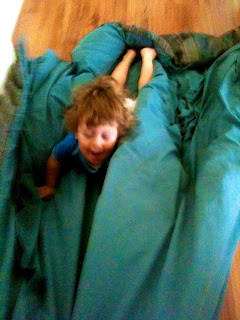Quilt rides
These photos are ridiculously bad - but quilt rides are always brilliant fun, and as we were moving about so much, the photos were really never destined to amount to much!
I remember dragging Master B. around on a doona/duvet/towel when he was really young too - practising tummy time. When kids lie on their tummy, resting on their elbows or pushing up on their hands whilst being pulled about, shoulder stability, neck and back strength (all essential for good posture) are encouraged. They get loads of sensory input* from being in the position itself, but also from whatever material is used, being wrapped around them. Moving about, encouraging kids to maintain a stable position further reinforces to the brain where the body is in space, as kids have to continuously hold and re-assume the position when they are thrown off balance.
*sensory input = information sent to the brain through the senses, about their body position(s) and movements
Ideas to try:
1. Varying the speed - from very slow to quite quick;2. Varying the amount of rocking/swerving/circling...;
3. Different quilts/materials: different textures send new messages back to the brain about the body's positioning. Sheets, throw rugs, sheep skins, doonas/duvets, camp mattresses, ...
4. Sliding on a large towel to or from the bathroom before or after a bath/shower;
5. Different positions - tummy, back, side/curled up, straight, arms/legs outstretched like a jellyfish/star...
6. Fully wrapping up snugly - like a cacoon. This idea is sometimes good for kids who are on the sensory sensitive side.
7. Use your imagination - allow your child to use their imagination... maybe you are riding wild waves in the ocean, or being a crocodile/fish/snake....
8. Move about to music - adapt the quilt ride to the pace and beats and moods of the music.
A word on safety:
- Keep an eye on how they are balancing - are they holding on well? are they rolling about everywhere and falling off to the side? etc... Start off slowly, and get a good grip of the material on either side of their body to avoid falling off.
- Clear a path for the rides! Watch out for corners and walls etc!!!!
Important Note:
Remember to watch for how your child is responding - are they enjoying it? are they scared? etc.. You want it to be a fun experience, not torturous!! Try stopping for brief pauses/breaks frequently, to give the child a chance to catch their breath and calm down. The activity needn't be long either - just a few minutes can still be lots of fun. Kids respond differently to different sensory activities. If you have any concerns, an occupational therapy assessment is recommended, as how a child processes sensory information can affect many aspects of learning, development and life in general.








Comments
Post a Comment